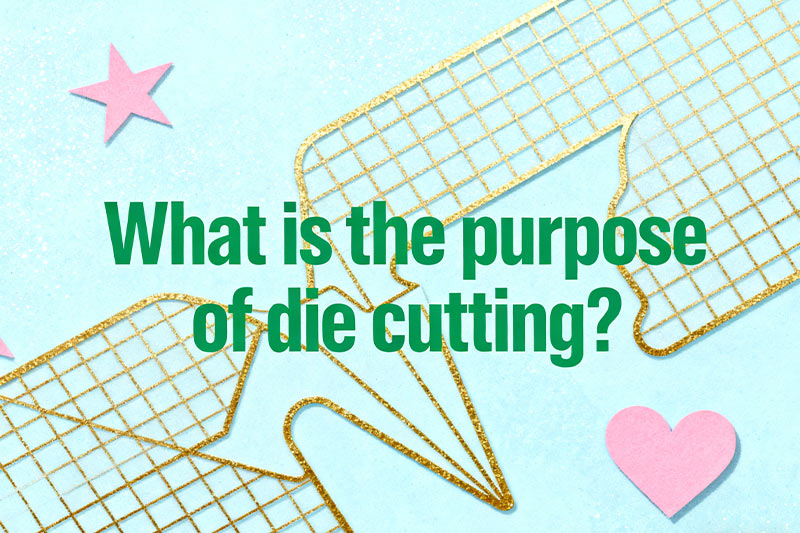In the realm of manufacturing, packaging, electronics, and beyond, die cutting stands as a foundational precision technology—yet many still ask, “What is the purpose of die cutting?” Far more than just “cutting materials,” die cutting serves strategic roles that streamline production, enhance product quality, and unlock design flexibility for businesses worldwide. This article breaks down its four core purposes, explores real-world applications, and explains why it remains a non-negotiable tool for industries ranging from consumer goods to medical devices.

The primary purpose of die cutting is to create uniform, intricate shapes from materials with exceptional accuracy—a feat that manual cutting or generic tools cannot match. Unlike hand-cutting, which leads to inconsistencies (e.g., uneven edges, size variations) and high error rates, die cutting uses custom-engineered “dies” (sharp, metal blades formed into specific shapes) to slice, score, or crease materials in a single press.
This precision is critical for industries where consistency directly impacts product performance. For example:
In packaging manufacturing, die cutting shapes cardboard into gift boxes, cereal cartons, or folding cartons—ensuring every package fits perfectly, reduces material waste, and maintains brand aesthetics.
In electronics, it cuts thin, delicate materials like copper foil, insulation films, or adhesive tapes into micro-sized components (e.g., phone battery separators, circuit board gaskets) with tolerances as tight as 0.1mm.
In textiles, die cutting shapes fabric for apparel labels, sportswear logos, or furniture upholstery—avoiding fraying and ensuring every piece aligns with design specs.
By eliminating human error, die cutting ensures 99%+ consistency even in high-volume production (e.g., 10,000+ units per hour), making it essential for mass-produced goods.
Another key purpose of die cutting is its ability to handle hundreds of materials—from thin, flexible films to thick, rigid substrates—without compromising quality. This versatility lets businesses use a single technology for multiple applications, reducing equipment costs and simplifying workflows.
Common materials processed via die cutting include:
Paper & cardboard (packaging, flyers, labels)
Plastics (PVC, PET, foam for electronics enclosures or toy parts)
Metals (aluminum foil for food packaging, thin steel for gaskets)
Adhesives (double-sided tapes, sticky labels, medical bandages)
Specialty materials (foam, rubber, felt, and even medical-grade films for surgical drapes)
For instance, in the medical industry, die cutting processes sterile, hypoallergenic films into precise shapes for wound dressings—ensuring compliance with strict health standards. In automotive manufacturing, it cuts foam gaskets for door seals and rubber components for dashboard wiring, adapting seamlessly to both soft and rigid materials.
Die cutting is designed to boost production speed and lower per-unit costs—a purpose that directly addresses businesses’ bottom-line goals. Unlike traditional cutting methods (e.g., laser cutting for small batches or hand tools), die cutting operates in “batch mode” or continuous feeds, enabling rapid processing of large quantities.
Consider these efficiency gains:
A flatbed die cutter can process up to 5,000 sheets of cardboard per hour, compared to 500 sheets with manual cutting.
Rotary die cutting (used for continuous materials like rolls of paper or plastic) can run 24/7, cutting materials at speeds of 100+ meters per minute—ideal for fast-moving consumer goods (FMCG) like diapers, or snack packaging.
Cost savings also come from reduced waste: die designs are optimized to nest shapes tightly on material sheets, cutting scrap rates from 20-30% (manual cutting) to 5% or less. For a packaging company producing 1 million boxes annually, this translates to thousands of dollars in material savings.
Beyond cutting, die cutting serves the purpose of improving how products work and look—a factor that drives consumer preference and brand differentiation. It can add functional features (e.g., easy-tear notches, fold lines) or decorative elements (e.g., intricate cutouts, embossed patterns) that manual methods cannot replicate.
Examples of this purpose in action:
Consumer electronics: Die-cut foam inserts in laptop boxes hold components securely during shipping, while die-cut mesh screens in phone cases allow airflow without compromising protection.
Beauty & cosmetics: Die-cut window cutouts in lipstick boxes let customers see the product color, while scored fold lines ensure boxes open smoothly—enhancing unboxing experiences.
Printing & marketing: Die-cut business cards with rounded edges or custom shapes (e.g., a coffee shop’s card shaped like a coffee cup) stand out from standard designs, boosting brand recall.
Nearly every industry benefits from die cutting’s core goals. Here’s how it supports critical sectors:
| Industry | Die Cutting Application | Core Purpose Served |
|---|---|---|
| Packaging | Cartons, labels, gift boxes | Precision, efficiency, aesthetics |
| Electronics | Circuit board components, insulation films | Precision, material versatility |
| Medical | Wound dressings, surgical tools | Precision, sterile processing |
| Automotive | Gaskets, wiring insulation, interior trim | Material versatility, durability |
| Textiles | Apparel labels, upholstery shapes | Consistency, speed |
To maximize die cutting’s benefits, businesses must select the method that aligns with their materials and volume needs:
Flatbed Die Cutting: Best for thick, rigid materials (e.g., cardboard, foam) and small-to-medium batches.
Rotary Die Cutting: Ideal for thin, flexible materials (e.g., plastic rolls, adhesive tapes) and high-volume production.
Laser Die Cutting: Used for ultra-precise, complex shapes (e.g., micro-electronics) or heat-sensitive materials.
In short, the purpose of die cutting is to solve three critical challenges for businesses: consistency at scale, versatility across materials, and efficiency that cuts costs. As industries evolve—with demands for smaller components (electronics), sustainable packaging (FMCG), and sterile medical products—die cutting continues to adapt, solidifying its role as a cornerstone technology.
For businesses looking to optimize production, enhance product quality, or expand design capabilities, understanding die cutting’s core purposes is the first step toward leveraging its full potential. Whether you’re a small packaging firm or a large electronics manufacturer, die cutting can be tailored to meet your unique needs—driving growth and competitiveness in a fast-paced market.
GET A QUOTE